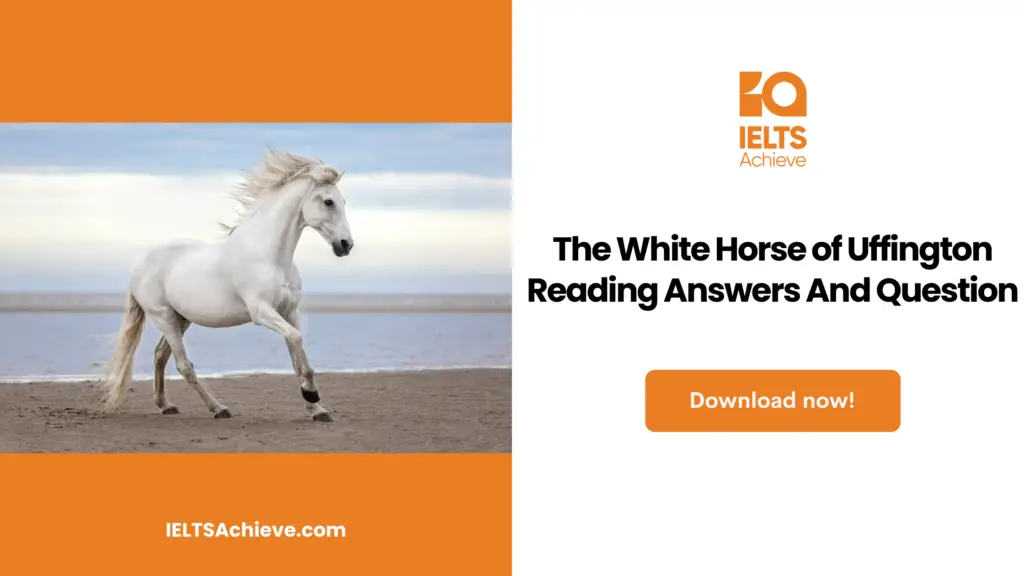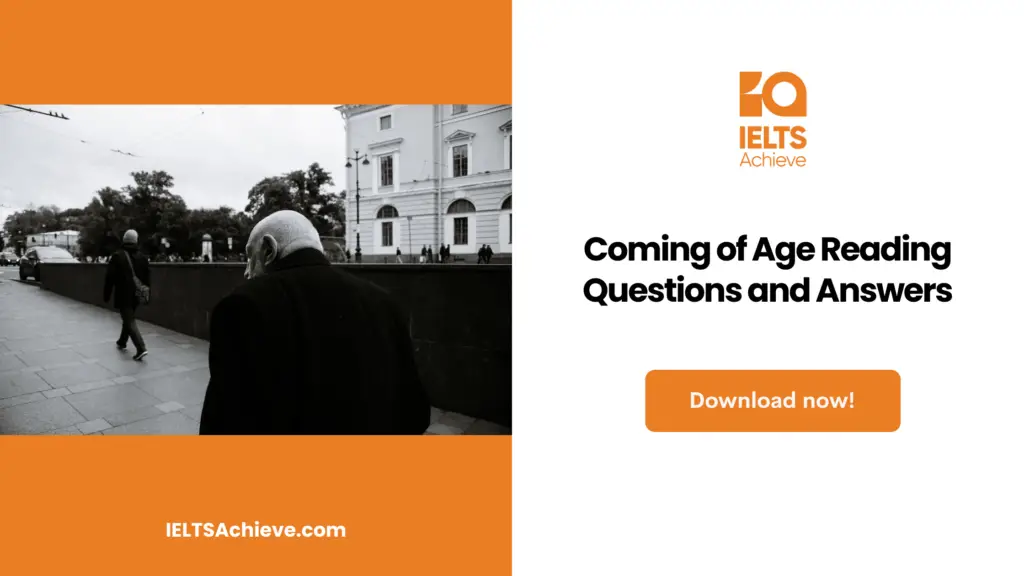The Blog post contains the following IELTS Reading Questions:
- IELTS Reading true/false/not given
- IELTS Reading short answer questions
- IELTS Reading note completion
Stay informed and prepared for success – Explore our comprehensive Reading Test Info page to get valuable insights, exam format details, and expert tips for mastering the IELTS Reading section.
IELTS Reading Passage-The White Horse of Uffington

The White Horse of Uffington.
Since more than 3,000 years ago, enormous sculptures, or “geoglyphs,” have been carved into the dirt of English hillsides. There are 56 hill figures spread around England. The great majority of them are located on the chalk downlands of the southern counties. There are giants, horses, crosses, and regimental insignia among the figures. Despite the fact that the bulk of these geoglyphs was created during the previous 3000 years, there are a few that are far older.
The most renowned of these statues, the Uffington White Horse in Oxfordshire, is also the most mysterious. The White Horse has lately been redated and proved to be even older than the ancient pre-Roman Iron Age* age originally attributed to it. The dating of the mysterious Long Man of Wilmington in Sussex is more debatable. While many historians believe the figure is prehistoric, some believe it was carved between the 11th and 15th centuries by an artistic monk from a local priory.
In order to expose the sparkling white chalk beneath these colossal sculptures, it was just necessary to chop away the grass on top. However, the grass would quickly grow back over the geoglyph if it was not routinely cleaned or scoured by a sizable human team. One reason for the demise of the vast majority of hill figures is that folks no longer bothered or remembered to sweep aside the grass to reveal the chalk outline when the traditions associated with the figures vanished. In addition, over the course of hundreds of years, the geoglyph’s initial shape would occasionally vary as a result of humans not always carving in the same location, resulting in a changing outline. The fact that any old hill figures remain in England attests to the power and durability of local customs and beliefs, which, in at least one example, must date back millennia. The Uffington White Horse is a distinctive stylized image of a horse with a long, slender back, thin, disconnected legs, a flowing tail, and a bird-like beaked head. The graceful creature nearly blends into the scenery. The horse is located 2.5 kilometers from Uffington hamlet on a steep slope next to the Late Bronze Age hillfort of Uffington Castle (about 7th century BCE) and below the Ridgeway, a long-distance Neolithic** route.
Also surrounding the Uffington Horse are Bronze Age burial mounds. It is close to the well-preserved Bronze Age cemetery of Lambourn Seven Barrows, which has over thirty burial mounds. As is the case with many geoglyphs, the sculpture is best viewed from above, as it has been positioned such that it is nearly impossible to observe from a close distance. Nonetheless, there are portions of the Vale of the White Horse, the valley holding and named after the mysterious beast, from which a sufficient impression may be derived. On a clear day, the sculpture is visible up to 30 kilometers distant.
The first mention of a horse in Uffington dates back to the 1070s CE, when ‘White Horse Hill’ is recorded in papers from the adjacent Abbey of Abingdon, and the first mention of the horse itself follows shortly thereafter in 1190 CE. However, it is thought that the carving dates back far further than that. Due to the similarities between the Uffington White Horse and the stylized portrayals of horses on coins from the 1st century BCE, it was believed that the creature dated to the same era.
In 1995, the Oxford Archaeological Unit conducted Optically Stimulated Luminescence (OSL) tests on dirt from two of the horse’s lower body layers and a sample was taken at the base. The result was a date for the horse’s creation between 1400 and 600 BCE, indicating that it originated around the Late Bronze Age or Early Iron Age. The latter end of this date range would link the horse sculpture to the nearby Uffington hillfort, hinting that it may be a tribal symbol identifying the hillfort’s inhabitants’ land. Alternately, the carving may have occurred during a Bronze Age or Iron Age ceremony. Some experts believe It is said that the horse represents the Celtic horse goddess Epona, who was revered as a guardian of horses and for her links to fertility. However, Epona worship was not brought from Gaul (France) until about the first century CE. This date is at least six centuries after the probable carving of the Uffington Horse. Despite this, the horse had significant ceremonial and economic importance during the Bronze and Iron Ages, as seen by its representation on jewelry and other metal things. It is probable that the sculpture portrays a native deity, such as Rhiannon, who is depicted in later Welsh mythology as a lovely woman riding a white horse and clad in gold.
The ease with which geoglyphs may vanish, as well as the rituals and importance associated with them, shows that they were never intended to be more than gestures. However, this does not diminish their significance. These enormous engravings provide a fascinating peek into the thinking of their makers and how they perceived the environment in which they lived.
*Iron Age: a time period (in Britain, 800 BCE to 43 CE) marked by the employment of iron implements. *Bronze Age is a time period (in Britain, around 2,500 BCE to 800 BCE) distinguished by the invention of bronze implements. *Neolithic: a time period (in Britain, c. 4,000 BCE – c. 2,500 BCE) notable for the expansion of agriculture and the use of stone tools. The ancient people who came from Europe to Britain before the Romans.
Unlock your full potential in the IELTS Reading section – Visit our IELTS Reading Practice Question Answer page now!
Recommended Questions:
Renewable Energy IELTS Reading Question with Answer
Questions 1–5
Do the following statements agree with the information given in the reading passage? In boxes 1–5 on your answer sheet, write:
True if the statement agrees with the information.
False if the statement contradicts the information.
It is not given if there is no information on this
1 Most geoglyphs in England are located in a particular area of the country.
2 There are more geoglyphs in the shape of a horse than any other creature.
3. A recent dating of the Uffington White Horse indicates that people were mistaken about its age.
4 Historians have agreed about the origins of the Long Man of Wilmington.5. Geoglyphs were created by people placing white chalk on the hillside.
Enhance your skills in identifying information as True, False, or Not Given. Click here to discover expert strategies and techniques for mastering this question type in the IELTS Reading section.
Questions 6-8
Answer the following questions.
(note:- no more than 2 words)
6. How many hill figures were scattered around England?
7. The Bronze Age cemetery of Lambourn consists of what?
8. Who was worshipped as a protector of horses?
Questions 9 – 13
Complete the notes below. Choose ONE WORD ONLY from the passage for each answer.
Write your answers in boxes 9-13 on your answer sheet.
The location of the Uffington White Horse:
- a distance of 2.5 km from Uffington village
- near an ancient road known as the 9 ……………………
- close to an ancient cemetery that has several burial mounds
Dating the Uffington White Horse:
- the first reference to White Horse Hill appears in 10 …………………… from the 1070s
- horses shown on coins from the period 100 BCE – 1 BCE are similar in appearance
- according to the analysis of the surrounding 11 ……………………, the Horse is Late Bronze Age / Early Iron Age
Possible reasons for the creation of the Uffington White Horse:
- an emblem to indicate land ownership
- formed part of an ancient ritual
- was a representation of goddess Epona – associated with the protection of horses and 12……………………
- was a representation of a Welsh goddess called 13 ……………………
Boost your performance in Summary, Notes, Table, and Flowchart Completion tasks. Click here to explore our detailed guide and learn how to effectively complete summaries, notes, tables, and flowcharts in the IELTS Reading section.
Unlock your full potential in the IELTS Reading section – Visit our IELTS Reading Practice Question Answer page now!
Recommended Questions:
Renewable Energy IELTS Reading Question with Answer
The White Horse of Uffington IELTS Reading Answers
Answer 1. True
Answer 2. Not given
Answer 3. True
Answer 4. False
Answer 5. False
Answer 6. 56
Answer 7. Burial-mounds
Answer 8. Goddess Epona
Answer 9. Ridgeway
Answer 10. Documents
Answer 11. Soil
Answer 12. Fertility
Answer 13. Rhiannon

We hope you found this post useful in helping you to study for the IELTS Test. If you have any questions please let us know in the comments below or on the Facebook page.
The best way to keep up to date with posts like this is to like us on Facebook, then follow us on Instagram and Pinterest. If you need help preparing for the IELTS Test, join the IELTS Achieve Academy and see how we can assist you to achieve your desired band score. We offer an essay correction service, mock exams and online courses.

